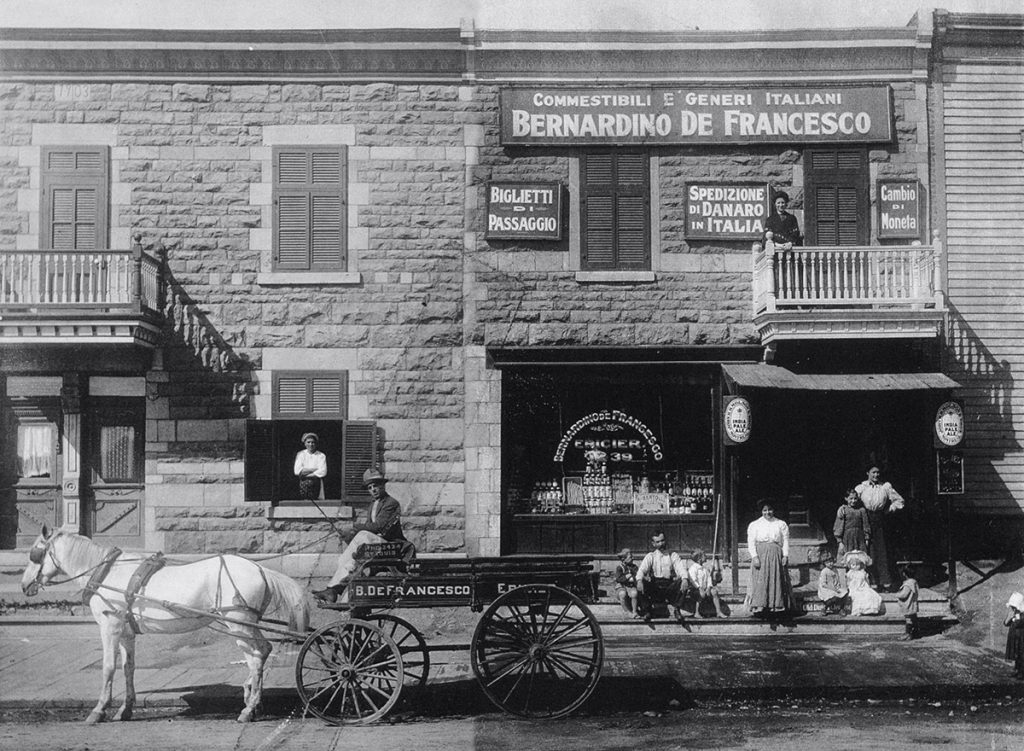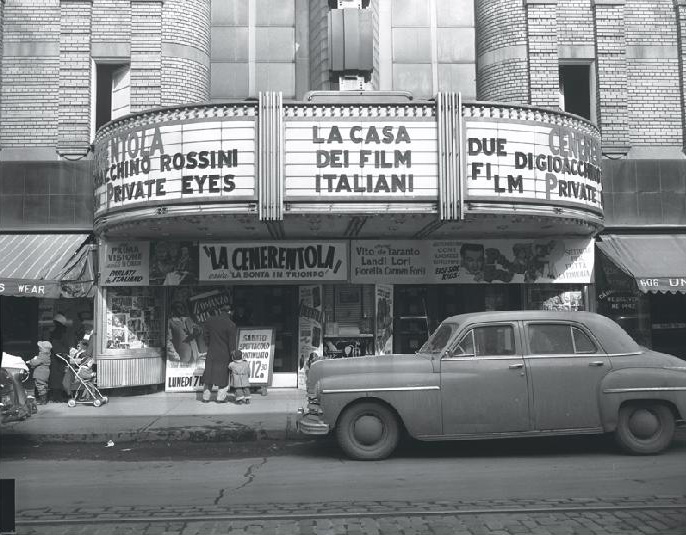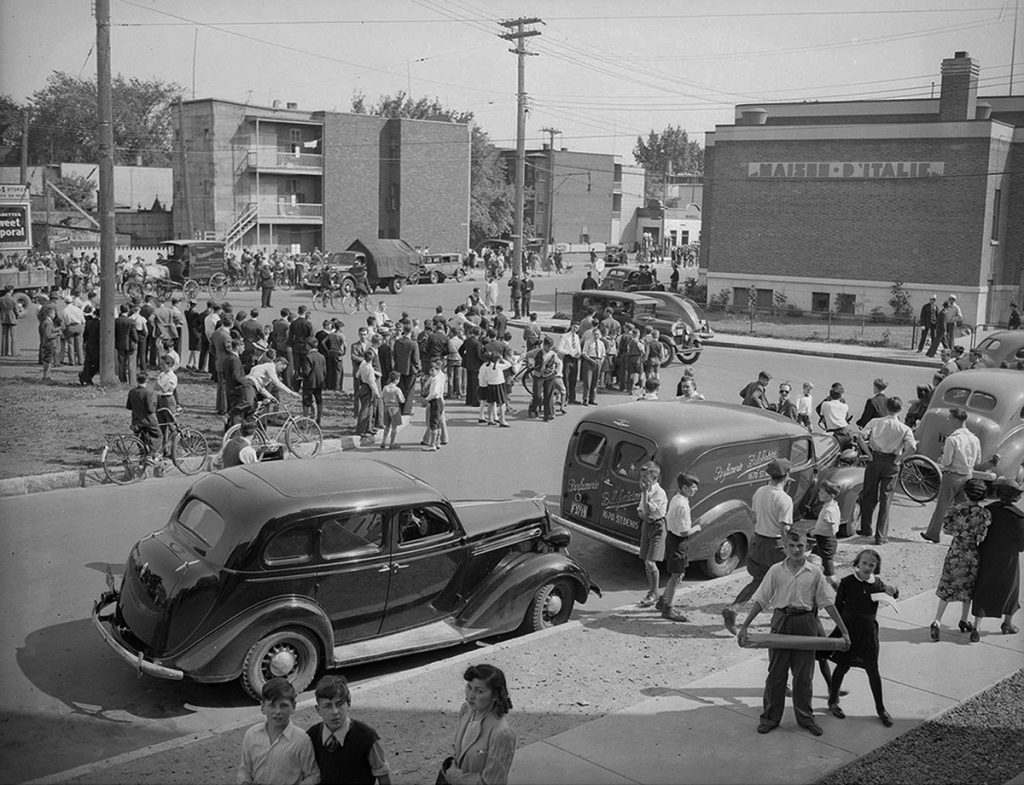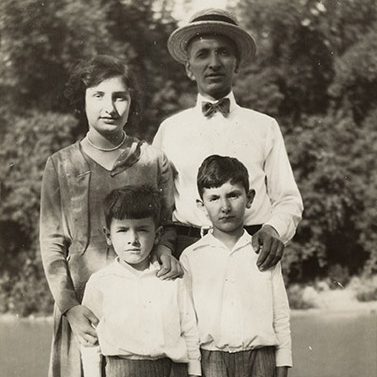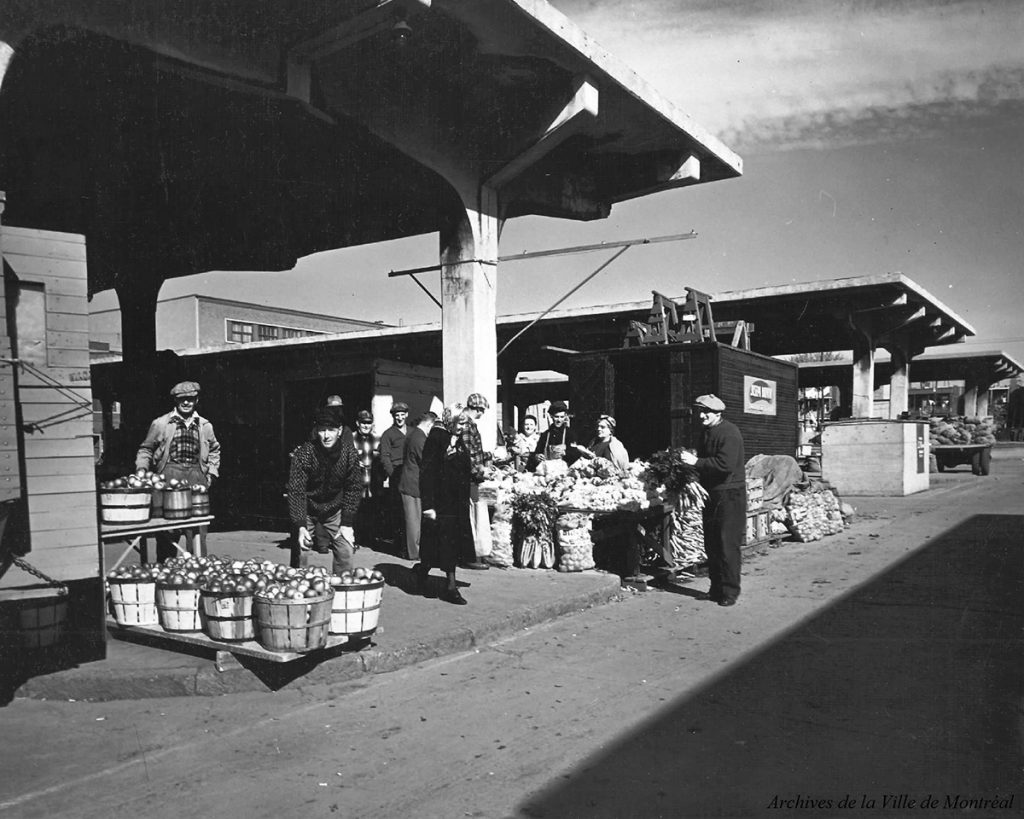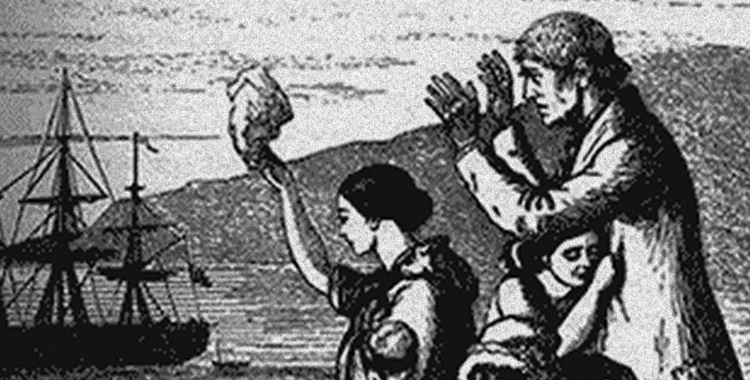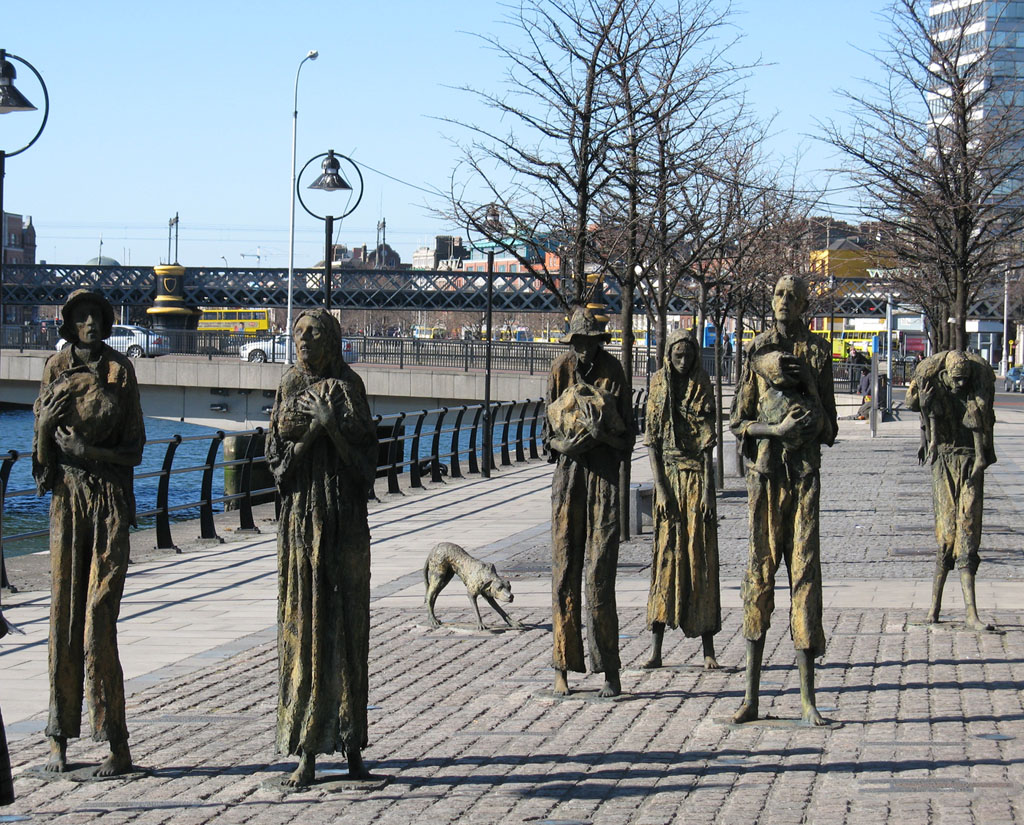Educator Tools

 Ask yourself:
Ask yourself:
- During the Second World War were the Japanese internment camps the only internment camps in Canada?
- What did Italian Canadian immigrants experience during the Second World War?
- Were Italian Canadians seen as a threat to Canadian democracy?
- What hardships did Irish immigrants face and how were they treated when they arrived on our shores in the 19th century?
Fleeing poverty and disease, thousands of Irish refugees, mostly Catholic, fled their homeland for Canada in the 19th century. Although the term “boat people” first became a popular label for the thousands of refugees fleeing Vietnam in the late 1970s, there have been many similar groups of immigrants. Perhaps the earliest were the Irish who came in the 19th century. In the late 1800s and early 1900s, many Italian immigrants, also Catholic, entered Canada escaping economic difficulties that began in the 1860s. You will explore the conditions and challenges experienced by these two groups in Canada.
This really happened
Despite being classified as “undesirable” according to Canada’s immigration policy during the late 19th and early 20th century, thousands of Italians immigrated to Canada to take advantage of family networks and Canadian labour shortages. The waves of immigration came in three periods: 1870-1914, 1920-1930, and 1950-1970. Italians were considered unsuitable for settling farmland on the prairies, which was the main immigration policy of the Canadian government at the time. Therefore, Italian immigration was not actively encouraged. Nevertheless, due to poor economic conditions in Italy, many risked being unwelcome and immigrated to Canada. The demand for inexpensive labour in industries such as the railways, construction, and manufacturing led to the immigration of more than 600,000 Italians between 1910 and 1930.
The first Italian immigrants to Canada settled in Toronto and Montreal, while some went to Vancouver as well as to mining and industrial towns across the country. The majority worked in construction or skilled building trades, while a few became small businessmen or found jobs on western Canadian farms and in the orchards of British Columbia. Due to the constant supply of labour needed by the railroad for construction, maintenance, and work in subsidiary mining companies, many young Italian men arrived as seasonal labourers. They usually bought one-way tickets and were often attracted by agents who charged a fee to arrange transportation and employment assistance. When agents had fewer jobs available than the number of men they brought from Italy, some of the seasonal migrants were unable to return home to Italy and were left stranded in Canada.
The remaining labourers formed the roots of Italian communities in Canada, and in the biggest cities this created ethnic enclaves known as “Little Italy” or, in Montreal, “Piccola Italia.” Migration increased when women and children joined their husbands and fathers in Canada. These Italian enclaves quickly grew into vibrant neighbourhoods, rich with Italian restaurants, shops, and other businesses.
In 1930, the Canadian economy was declining due to the stock market collapse and subsequent depression. The government imposed strict regulations to reduce the number of prospective immigrants. During the Second World War, restrictions on immigration were further increased, specifically against those from enemy nations such as Mussolini’s Italy, which was allied with Hitler and Nazi Germany. In 1940, under the War Measures Act, out of a total of over 112,000 Italians living in Canada, approximately 31,000 were officially classified as enemy aliens. The Canadian government perceived Italians and other enemy aliens as a threat to national security, which led to their internment.
By the late 1930s, fascists had worked to promote their cause among expats leading to some pro-fascist supporters among Italian-Canadian organizations. There were relatively few who were committed to this ideology, however, and the majority of Italians in Canada were patriotic toward their new country. The RCMP was watching the Italian immigrant community and compiling lists of fascist sympathizers when in 1939, Canada declared war on Germany. Many Italian-Canadians were shocked by Mussolini’s alliance with Hitler and after Canada declared war on Italy on June 10, 1940 life became challenging for them. Young Italian men enlisted in the Canadian military and Italians demonstrated their patriotism by buying Victory Bonds, holding fund-raising events for the Allied cause, planting victory gardens, and organizing school children to collect salvage – metal, paper, and other items to recycle for use during the war.
The War Measures Act was applied in 1940 stating: “Italian-Canadians over the age of eighteen were declared ‘enemy aliens’ as well as those who became citizens after September 1, 1922.” Organizations found to have fascist leanings were declared illegal and shut down, and the RCMP arrested Italian-Canadians who were on their lists of alleged fascist or communist supporters. Shops and businesses owned by Italian-Canadians were vandalized, many suffered verbal abuse, ostracism, and discrimination in the workplace, and children were teased and bullied at school. (German Canadians suffered the same treatment during both world wars.)
Almost 600 men were arrested and interned at Camp Petawawa, ON or Camp Ripples, NB for months to years without being charged or convicted of any crimes. Their jackets were painted with big red circles on the back to make it easier for the guards to shoot them if they tried to escape. The youngest Italian Canadian interned was only 16 years old. Four women were also detained at Kingston Penitentiary for Women. The incarcerated men felt helpless since their internment meant loss of the income for their families, who suffered terribly as a result. Their bank accounts were frozen and they were disqualified for welfare. Landlords refused to rent to them during those years. For all Canadians, life on the home front was challenging; for those in the Italian Canadian community, it was compounded by stigma, a loss of community leadership and a sense of shame. After being imprisoned as criminals, some of the enemy aliens who were released, were immediately drafted into the Canadian army to help fight in the Second World War. Those who tried to resettle in their communities were often shunned or threatened and had to leave town.
 Artifacts
Artifacts
Artifact 1 ›
The Minister of Justice has authorized the Royal Canadian Mounted Police to take steps to intern all residents of Italian origin whose activities have given ground for the belief or reasonable suspicion that they might in time of war endanger the safety of the state or engage in activities prejudicial to the prosecution of the war . . . It would be a great mistake to underestimate the seriousness of the new situation which has been created.
Prime Minister William Lyon Mackenzie King
CBC Radio Address, June 10, 1940
Artifact 2 ›
Certificate of Naturalization 1929
Source: http://www.italiancanadianww2.ca
Ettore Sanguiro was born in Italy in March 25, 1881 and emigrated to Canada in 1923. His wife Luisa, and 8-year-old daughter Cesarina followed seven years later. Their second daughter Rosemarie was born in 1933 and they lived in Hamilton. On June 10, 1940, Sanguiro was arrested while they were eating dinner. Three RCMP officers kicked in the doors to their home, to the horror of the family, especially Rosemarie who was only seven at the time. Sanguiro was briefly detained in Toronto and then sent on to Petawawa internment camp until his release in 1942. His family were not allowed to see him even once during those few years.
Only after internees were detained, did the Canadian government actually begin investigating the degree to which these men actually constituted any sort of security threat. Some were released within months, while others remained in detention for years. Even after their release, internees often experienced discrimination in the work force or in their former neighbourhoods. Some were able to resume their former lives but experienced long-term guilt, embarrassment, or a sense of betrayal by others in their ethnic community. Some chose to anglicize their names or deny their cultural roots. However, changes in postwar immigration policy led to an influx of immigrants from postwar Italy and, with settlement in cities having established Italian Canadian communities, the “Little Italy” in Toronto, Windsor, and Winnipeg revived.
Artifact 3 ›
Photo of Eliseo Orlando and family 1930s
Source: http://www.italiancanadianww2.ca
Eliseo Orlando was a tailor who first lived in Toronto on Queen Street and then in the Beaches area with his wife, Maria and their three children (the eldest daughter was born in Italy and the two boys in Canada.) Maria was an excellent sewer. Eliseo and his two sons, Italo and Roy Orlando, were all arrested in 1940 and interned. Roy Orlando was only 16 years old, and was said to be the youngest Italian Canadian interned. The boys were taken from school without warning and held at the Canadian National Exhibition grounds after the mass arrests. Maria asked a friend, also designated as an enemy alien, to bring sweaters, their prayer book, and rosary to them.
Artifact 4 ›
Watch this video from the National Film Board on the internment of Italian Canadians.
The Aftermath
Even if a community moves on, a story like this should never be forgotten.
In the late 1940s, Italians were removed from the enemy alien list, prompting the largest wave of Italian immigration to Canada. Between the early 1950s and the mid-1960s, approximately 20,000 to 30,000 Italians immigrated to Canada each year. Family networks were important as family members already in Canada sponsored their relatives back home.
When immigrants landed in Canada, most arriving by ocean liner at Pier 21 in Halifax, Nova Scotia, they were processed by immigration officials. Then they boarded trains to take them to their final destinations, arriving at locations with unfamiliar climates and landscapes. In addition to discrimination, Italian immigrants experienced culture shock and a language barrier. Common prejudices claimed that Italians were prone to violence and that they might undermine the moral fabric of Canadian society by introducing fascism and organized crime in Canada. Italian immigrants, as well as other immigrant groups, were accused of taking jobs away from Canadians. They were also scorned for living in overcrowded and unhealthy conditions since they often lived in multiple-family homes.
Although Italian Canadians occasionally still experience some discrimination due to the harmful stereotypes of the last century, they are known today for strong family values and have contributed in many ways to the country — socially, economically and culturally. They have been very successful in all professions, businesses, politics and more. In Ontario, one major contribution has been in the area of labour reform and workplace safety regulation. The thriving Italian Canadian community today is a significant part of our society.
ACTION 1
Think
“The streets were not paved with gold. The streets were not paved. We were expected to pave the streets.”
— Pamela Hickman and Jean Smith Cavalluzzo, Righting Canada’s Wrongs: Italian Canadian Internment in the Second World War (Toronto: Lorimer, 2012), 26.
Although many Italian Canadian faced the injustice of being outsiders and were often viewed as second class citizens, they still remained here. After reading about their financial struggles in Italy and what they had to endure after arriving in Canada, consider their reasons for staying.
Do
From the point of view of an Italian Canadian, write a journal entry describing your experiences as a new Canadian from approximately 1939-1945, including your justifications for choosing to remain in this country.
ACTION 2
Discuss
And like immigrants from other European nations, Italians “came to a country where racist attitudes and conduct towards many groups was common and socially accepted.”
— Pamela Hickman and Jean Smith Cavalluzzo, Righting Canada’s Wrongs: Italian Canadian Internment in the Second World War (Toronto: Lorimer, 2012), 44.
In a small group, discuss the following: given the difficulties faced by Italian Canadians, do you think that if you were faced with the same discrimination you would choose to remain in Canada? Explain your reasoning in your group and then open it up to a class discussion.
ACTION 3
Do
A few years after Canada’s official apology to the Japanese-Canadian community in 1988, Prime Minister Brian Mulroney made a statement of apology to Italian Canadians. It was not considered an official apology, however, since his statement was made in a context that was outside Parliament. Internees and their families have never been granted financial compensation, although there has been some government support for programs in museums, memorials, books, and other activities to provide education about the Italian-Canadian internment experience. Is this acknowledgement enough? The Italian Canadian community is still divided about whether to fight for official redress and compensation, or to move on.
This apology helped Italian Canadians on the road to forgiveness toward Canada. What action(s) do you think Canada should take to properly apologize to the incarcerated Italians and their families?
Round Robin Response: in a group of four to five, create a piece of paper with the statement and question above written at the very top. When the paper comes to you, write your response. You must choose to agree or disagree with the statement and then explain why and what Canada should do to properly address this painful event in our history.
ACTION 4
Do
The War Measures Act was a federal law adopted by Parliament on August 22, 1914, after the outbreak of the First World War. It gave broad powers to the Canadian government to maintain security and order during war or insurrection. It was used, controversially, to suspend the civil liberties of people in Canada who were considered enemy aliens during both world wars, leading to mass arrests and detention without charge or trial.
Research the War Measures Act.
Research facts about, and consequences of, the Act and justify your opinion with these facts. Feel free to research other sites to increase your knowledge about the history of Canadian immigration after the First World War.
Then divide the class into two groups and hold a debate choosing either of these views:
A) Agreement with Canada on enforcing the War Measures Act
B) Disagreement with Canada on enforcing the War Measures Act
ACTION 5
Do
The Canadian Museum of Immigration at Pier 21, in Halifax, Nova Scotia, is a museum dedicated to the immigrant experience in Canadian history. Images, films, and compelling content convey the immigrant experience for so many people from around the world, many of whom first landed at Pier 21. Between 1928 and 1971, it was the entry point for one in five Canadians.
Focusing on the Italian experience, find images and words that speak to you, and create a collage as a response to their experience. These collages may be posted in your class or school hallway.
Access media from the Pier 21 site (and feel free to research additional sites).
Further Resources
Pamela Hickman and Jean Smith Cavalluzzo, Righting Canada’s Wrongs: Italian Canadian Internment in the Second World War (Toronto: Lorimer, 2012).
This book contains facsimiles of poignant letters (always censored) sent by family members to the men in the camps.
Italian Canadians as Enemy Aliens – watch videos
Montreal’s Little Italy
Irish Immigration to Canada in the 19th Century
This Really Happened
The Great Hunger (The Irish Famine)
Ireland is a majority Catholic country and was controlled by (Protestant) Britain beginning in 1801 as part of the United Kingdom. Except for six counties (now making up Northern Ireland) most Irish were Catholic living on small farms rented from largely English landlords. While Catholics had been systematically discriminated against, there was slow progress. In 1829, the Act of Emancipation allowed Catholics to run for Parliament. The population had grown significantly in this period due to the abundance of potatoes: a vegetable originally brought from the Americas. It became a staple of the poor, especially in winter. But it was unreliable and many times in the 18th and early 19th centuries there were crop failures of varying degrees of severity.
A blight that originated in North America and spread to Europe resulted in a series of failed potato crops in Ireland from 1845 to 1852. Mass starvation weakened thousands of survivors who then died of cholera. The deaths, plus the emigration that occurred, resulted in Ireland’s population decreasing from about 8 million in 1841 to about 2 million by 1860.
Ironically, during the years of the famine, Ireland still exported large quantities of food to Britain while Irish tenant farmers were going bankrupt and being removed from their small farms by landlords. The situation was summarized in a poem written by Miss Jane Francesca Elgee, a well-known and popular author who was also the mother of the famous playwright, Oscar Wilde. The poem was published in 1846 in The Nation newspaper.
Weary men, what reap ye? Golden corn for the stranger.
What sow ye? Human corpses that wait for the avenger.
Fainting forms, hunger-stricken, what see you in the offing
Stately ships to bear our food away, amid the stranger’s scoffing.
There’s a proud array of soldiers—what do they round your door?
They guard our master’s granaries from the thin hands of the poor.
Pale mothers, wherefore weeping? ‘Would to God that we were dead—
Our children swoon before us, and we cannot give them bread.
Source: Sir Charles Gavan Duffy (1888), Four Years of Irish History, 1845–1849 (Cassell, Petter, Galpin & Co.)
Many of the starving Irish emigrated to North America, but their troubles did not end with the decision to leave Ireland. Of the hundreds of thousands that immigrated to North America many died en route. Weakened by hunger they fell prey to diseases like cholera. It struck repeatedly around the world many times in the 19th century. People suspected of having this and other diseases were quarantined at Grosse Ile, Quebec, an island in the St. Lawrence River. The following table gives you a sense of the suffering based on the arrivals to Grosse Ile from 1825 to 1847.
Diseases
| Immigrants | Admitted to Hospital | Number of Deaths | Cholera | Fever and Dysentery | Smallpox | Other |
|---|---|---|---|---|---|---|
| 425,490 | 14,533 | 3,934 | 290 | 4,648 | 722 | 726 |
More would die in future years and many died en route. Perhaps 20,000 died of typhus in the “coffin ships” crossing the Atlantic.
ACTION 6
Think
Rank the Evidence
Which of the following pieces of evidence affects you? Use the following scale to help you rank the evidence.

 Artifacts
Artifacts
Artifact 1 ›
The Irish peasants came to North America in overcrowded and unsanitary ships known as “coffin ships.” Cabin passenger Robert Whyte recorded the horrifying conditions in the steerage section of a ship. “Passing the main hatch, I got a glimpse of one of the most awful sights I ever beheld. A poor female patient was lying in one of the upper berths—dying . . . She had been nearly three weeks ill and suffered exceedingly until the swelling set in, commencing in her feet and creeping up her body to her head. Her afflicted husband stood by her holding a “blessed candle” in his hand awaiting the departure of her spirit.”
Artifact 2 ›
Ships flying the flag of disease were forced to dock at the quarantine station on Grosse Isle, an island located in the St. Lawrence, down river from Quebec City. For many Irish immigrants it would be their only glimpse of the new land. In 1847, 50 people a day died of typhus at Grosse Isle. Dr. George Douglas, the medical officer in charge erected a plaque to mark a mass burial site: “In this secluded spot lie the mortal remains of 5,425 persons who, fleeing from pestilence and famine in 1847, found in North America but a grave.”
Artifact 3 ›
“The year 1847 shall be remembered in our history as the year of emigration. Close to 100,000 unhappy souls left Ireland to seek their break on the banks of the St. Lawrence. To compound their misery, fever decimated them at sea, in quarantine stations, in the villages, towns and country of the colonies of British North America.” La Minerve, January 3, 1848 (quoted in D. Gillmore and P. Turgeon, Canada: A Peoples’ History, vol. 1 (CBC, 2000), 249.
“We lay at some distance from the island the distant view of which was exceedingly beautiful. However, this scene of natural beauty was deformed by the dismal display of human suffering that it presented – helpless creatures being carried by sailors over the rocks on their way to the hospital, boats arriving with patients – some of whom died in their transmission from their ships. Another, and still more awful sight, was a continuous line of boats, each carrying its freight of dead to the burial ground and forming an endless funeral procession.” Ibid, 248.
Artifact 4 ›
About 30% of the starving Irish fleeing the famine were Protestant. Among these were John and Mary Willis and their five children. From Limerick in the west of Ireland they sailed on the Jesse, but one son was sick and had to be left behind. In the 56-day journey across the Atlantic, 26 passengers died in horrible conditions, including their 18-year-old son and their 10-year-old daughter, Martha. They were quarantined in Grosse Ile for thirteen days where Mary Ann Willis, the 17-year-old daughter died. The three remaining members were released to sail to Québec before travelling inland to Toronto. But the tragedy is not over. Both Mary’s husband and her remaining son would die of fever in Brantford, Ontario. Mary was alone and we know she stayed with a local family. There the historical record ends.
Between May and October of 1847, over 38,000 Irish Famine emigrants arrived in Toronto from Ireland at a time when the city’s population was just 20,000 people. The Toronto Waterfront witnessed one of the greatest human tragedies in the history of the city. Yet, unlike later decades there was little anti-Catholic resistance as this largely Protestant city, led by its Catholic community, did what it could for the refugees.
ACTION 7
iSearch
Was it a Genocide?
Some have called the Irish Potato Famine a form of genocide. Conduct a research project to determine the extent that this is true. Be sure to look at Unit Two on genocide in Voices into Action.
ACTION 8
iSearch
Take a look
Watch the White Pine Pictures production Scattering of Seeds. The episode The Force of Hope: The Legacy of Father McGauran looks at Grosse Isle.
In the Historica Canada Heritage Minutes, series one features the plight of Catholic orphans from the Irish Famine who were adopted by families in Québec.
ACTION 9
iSearch
Stop and think
How would you feel if unemployment was so high in your home country that you had to leave your family and friends to seek work in a foreign place?
How will you treat new immigrants to Canada who you meet at school, on a sports team, or in the workplace? Will you welcome new foreign students and invite them to join you and your friends for lunch or coffee?
Every effort has been made to gain permission from copyright holders to reproduce borrowed material. The publishers apologize for any errors and will be pleased to rectify them in subsequent reprints and website programming
Educator Tools


